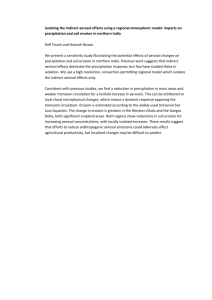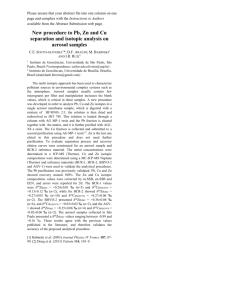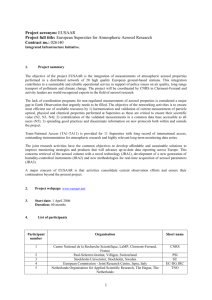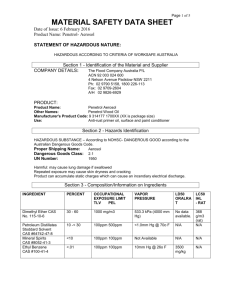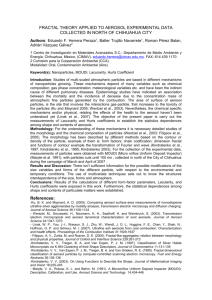Continuous Aerosol Therapy
advertisement
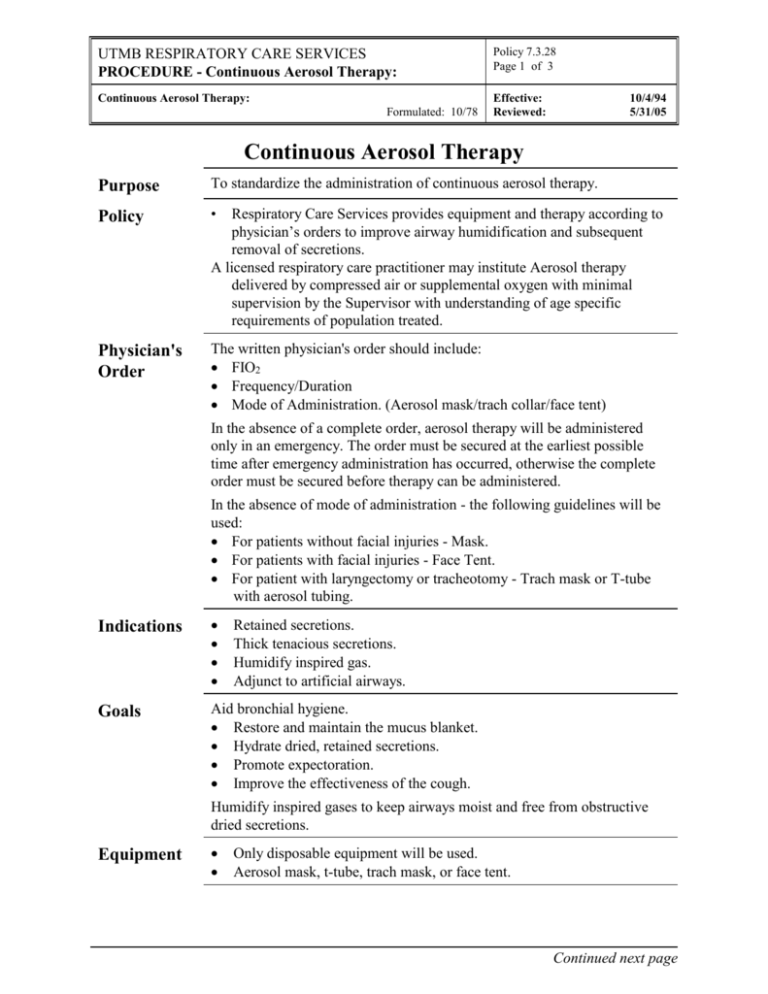
UTMB RESPIRATORY CARE SERVICES PROCEDURE - Continuous Aerosol Therapy: Policy 7.3.28 Page 1 of 3 Continuous Aerosol Therapy: Effective: Reviewed: Formulated: 10/78 10/4/94 5/31/05 Continuous Aerosol Therapy Purpose To standardize the administration of continuous aerosol therapy. Policy • Physician's Order The written physician's order should include: FIO2 Frequency/Duration Mode of Administration. (Aerosol mask/trach collar/face tent) Respiratory Care Services provides equipment and therapy according to physician’s orders to improve airway humidification and subsequent removal of secretions. A licensed respiratory care practitioner may institute Aerosol therapy delivered by compressed air or supplemental oxygen with minimal supervision by the Supervisor with understanding of age specific requirements of population treated. In the absence of a complete order, aerosol therapy will be administered only in an emergency. The order must be secured at the earliest possible time after emergency administration has occurred, otherwise the complete order must be secured before therapy can be administered. In the absence of mode of administration - the following guidelines will be used: For patients without facial injuries - Mask. For patients with facial injuries - Face Tent. For patient with laryngectomy or tracheotomy - Trach mask or T-tube with aerosol tubing. Indications Goals Aid bronchial hygiene. Restore and maintain the mucus blanket. Hydrate dried, retained secretions. Promote expectoration. Improve the effectiveness of the cough. Retained secretions. Thick tenacious secretions. Humidify inspired gas. Adjunct to artificial airways. Humidify inspired gases to keep airways moist and free from obstructive dried secretions. Equipment Only disposable equipment will be used. Aerosol mask, t-tube, trach mask, or face tent. Continued next page UTMB RESPIRATORY CARE SERVICES PROCEDURE - Continuous Aerosol Therapy: Policy 7.3.28 Page 2 of 3 Continuous Aerosol Therapy: Effective: Reviewed: Formulated: 10/78 Equipment Continued 10/4/94 5/31/05 Nebulizer kit. Aerosol tubing. Appropriate flow meter. In-line aerosol drainage bag. Procedure Step Action 1 Verify physicians order and patient ID, wash hands. 2 Explain safety regulations to patient, family and visitors. 3 Plug flow meter into outlet. 4 Attach nebulizer to flow meter. 5 Attach aerosol tubing to appropriate appliance and nebulizer. 6 Adjust venturi (located at the top or side of nebulizer cap) to prescribed FIO2. If room air is prescribed, attach to compressed air wall outlet. 7 Turn flow meter to recommended liter flow (sufficient to produce a good aerosol fog). Flow rates from the device should be high enough to meet patient's inspiratory needs. Settings should be set according to manufacturer's recommendations and verified by oxygen analysis. 8 Attach Trach Collar, T-tube, Aerosol Face Mask, or face tent. 9 Reinforce key points of therapy to the patient; then institute therapy. 10 Stay with patient until he is adjusted to the therapy. 11 Record pertinent data on flow sheet. Record initial set-up, document rounds and change-out of equipment on RCS Patient flow sheet and Department Treatment Card per RCS Policies # 7.1.1 and # 7.1.2. 12 Drain out any liquid that may be in the aerosol tubing into the drainage bag. Repeat as needed. Empty reservoir when indicated. Continued next page UTMB RESPIRATORY CARE SERVICES PROCEDURE - Continuous Aerosol Therapy: Policy 7.3.28 Page 3 of 3 Continuous Aerosol Therapy: Effective: Reviewed: Formulated: 10/78 10/4/94 5/31/05 Undesirable Side Effects Contact physician if any of these result from this therapy for reassessment of therapy. Airway obstruction may result from the swelling of dried, retained secretions. These secretions are hydrophilic and will swell when they absorb water. This may result in acute lower airway obstruction. Aerosol induced bronchospasm. Fluid overload especially in infants receiving continuous therapy. Note: There is no documentation to demonstrate fluid overload in the adult receiving intermittent therapy. Assessment of Outcome Assessment of: Blood gas measurements and oximetry. Work of breathing. Assessment of the cardiopulmonary system. Color Discontinuation of Orders Patients will be evaluated after every treatment. A complete pulmonary assessment will be done every 72 hours as indicated. Based on the assessment, the therapist will make recommendations for changes in therapy or discontinuance as needed. Infection Control Follow procedures outlined in Healthcare Epidemiology Policies and Procedures #2.24; Respiratory Care Services. http://www.utmb.edu/policy/hcepidem/search/02-24.pdf Patient Teaching Explain to the patient why he/she is receiving continuous aerosol. Assure proper body alignment for maximal breathing efficiency. Proper cough instruction or cough assistance. As a result of the educational aspects of this therapy the patient should be able to verbalize and demonstrate his understanding of this therapy. References AARC Clinical Practice Guidelines, Bland Aerosol Administration – 2003 Revision &Update, Respiratory Care 2003; 48:(5) 529-533 Fink J; Humidity and Aerosol Therapy. In: Scanlan CL, Spearman CB, Sheldon RL, Eds. Egan's Fundamentals of Respiratory Care, Eighth Edition, Mosby; June 2, 2003 Lawrence JC. Humidification practices in the adult intensive care unit, Prince of Wales Hospital. Respiratory Care Clinics of North America. 1998; 4:301-304. Op't Holt TB; Aerosol generators and humidifiers. In: Barnes TA, Ed. Core Textbook of Respiratory Care Practice. 2nd edition. St. Louis: Mosby-Year Book; 1994.


